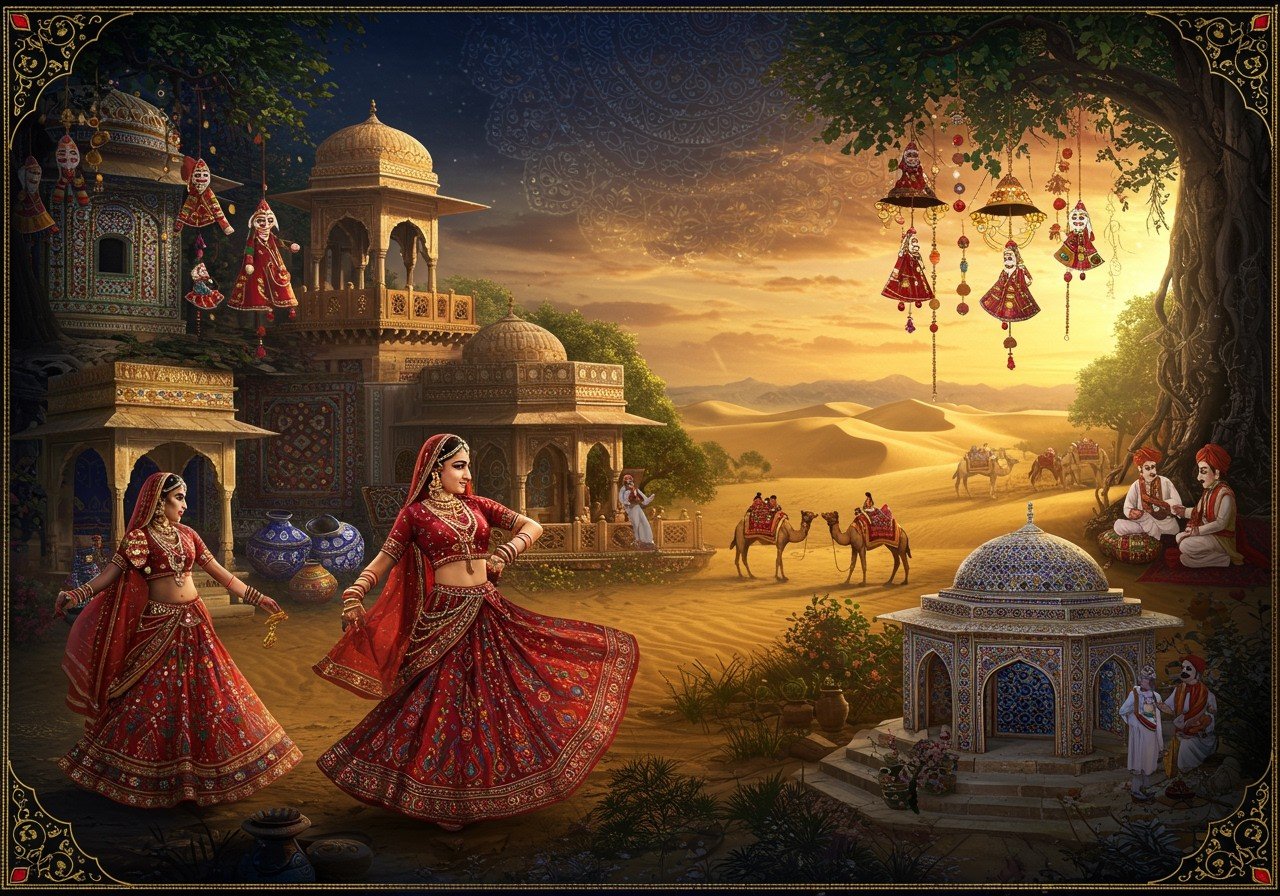
Rajasthan, India’s largest state, is famous for its majestic forts and palaces. But beyond these iconic landmarks lies a treasure trove of cultural experiences waiting to be discovered. This blog post delves into the lesser-known aspects of Rajasthani culture, from its vibrant cuisine and intricate arts and crafts to the significant role of temples in society. Join us as we explore these hidden gems and gain a deeper appreciation for Rajasthan’s rich heritage.
Savoring the Flavors of Rajasthan: Cuisine and Festivals
Rajasthani cuisine is an integral part of the state’s cultural identity, deeply intertwined with its festivals and rituals. Traditional dishes like Dal Baati Churma, Gatte Ki Sabzi, and Laal Maas aren’t just meals; they’re culinary stories passed down through generations. These delicacies are often prepared during major festivals such as Diwali, Holi, and Teej, using seasonal ingredients that showcase the resourcefulness of Rajasthani cooking.
Food in Rajasthan is more than sustenance; it’s a celebration of community and togetherness. Sharing meals is a cherished tradition, strengthening bonds and creating lasting memories. Festive occasions call for special treats like Ghewar and Mawa Kachori, adding sweetness to the celebrations. The cultural significance extends to the preparation and serving of food, often involving traditional utensils and silverware.
While honoring time-honored recipes, Rajasthani cuisine also embraces modern adaptations. Chefs and home cooks alike find innovative ways to present traditional dishes, catering to contemporary palates while preserving the essence of Rajasthani flavors.
Poojn.in offers a variety of traditional puja items to enhance your festive celebrations.
The Artistry of Rajasthan: Traditional Arts and Crafts
Rajasthan is a haven for artisans, showcasing a remarkable array of traditional arts and crafts. The intricate designs and masterful craftsmanship are evident in textiles like Bandhani, Leheriya, and Kota Doria. Each piece tells a story of skilled hands and artistic vision.
Beyond textiles, Rajasthan’s artistic heritage shines through its handicrafts. Blue Pottery, with its mesmerizing hues, Pichwai paintings depicting religious narratives, and the timeless elegance of marble carving all hold cultural significance. These crafts are not merely decorative; they represent the soul of Rajasthan.
Jewelry making in Rajasthan is an art form in itself. Techniques like Kundan, Meenakari, and Thewa, rooted in history, continue to adorn generations. The delicate artistry and intricate details reflect the rich cultural legacy of the region.
Puppet making and Kathputli performances are more than just entertainment; they are a living embodiment of Rajasthani folklore and storytelling. These traditions preserve the stories and legends that have shaped the cultural landscape.
The craftsmanship extends to leatherwork, with Mojari shoes and intricately designed bags reflecting the state’s artistic prowess. Traditional crafts play an integral role in weddings and other ceremonies, adding cultural richness to these important life events. Government initiatives and local organizations play a crucial role in supporting and promoting these art forms, ensuring their continuity for generations to come.
Discover exquisite handcrafted jewelry and other traditional crafts at Poojn.in.
Spiritual Sanctuaries: The Role of Temples in Rajasthani Society
Temples in Rajasthan are not merely places of worship; they are vibrant centers of community life and cultural preservation. These sacred spaces play a vital role in shaping the social fabric of the state.
The architectural splendor of temples like the Dilwara Temples, Eklingji Temple, and Ranakpur Jain Temple showcases the unique artistic traditions of the region. These temples serve as venues for religious festivals and fairs, fostering cultural exchange and community bonding.
Daily rituals, such as morning and evening aartis, are an integral part of life for many Rajasthanis. Temples act as custodians of art and music, often nurturing traditional dance and music forms. Beyond spiritual guidance, temples provide essential community services, including education, healthcare, and charitable initiatives.
Pilgrimages to these temples not only offer spiritual solace but also contribute to the local economy and help preserve cultural heritage. However, temples in Rajasthan face the challenge of maintaining relevance in contemporary society while upholding their traditional practices. Balancing these two aspects is crucial for their continued role in the community.
Find beautiful murtis and other puja essentials for your home temple at Poojn.in.
Beyond the Tourist Trail: Exploring Hidden Gems
Rajasthan’s allure extends beyond the popular tourist destinations. Hidden gems like Jojowar, with its lush vegetation and scenic train journeys through the Aravalli hills, offer a glimpse into the state’s natural beauty. Nagaur, home to India’s largest saltwater lake, Sambhar Lake, provides a unique travel experience. These lesser-known destinations offer a blend of natural beauty, historical significance, and local charm. The ideal time to visit these hidden spots is between October and March, when the weather is pleasant.
Embracing the Essence of Rajasthan
Exploring Rajasthan’s hidden cultural treasures unveils a deeper connection to India’s rich heritage. Through its cuisine, traditional arts and crafts, and the vital role of temples, one can truly appreciate the depth and vibrancy of Rajasthani culture. These aspects highlight the state’s historical significance and its ongoing evolution in the modern world.


